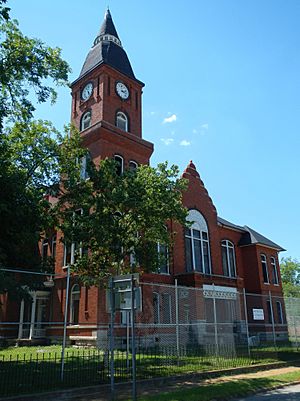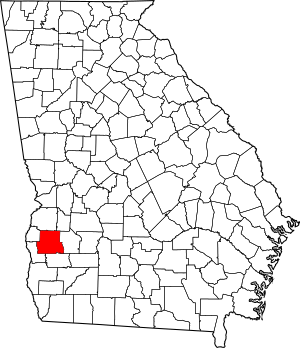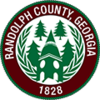Randolph County, Georgia facts for kids
Quick facts for kids
Randolph County
|
||
|---|---|---|

The Randolph County Courthouse in Cuthbert was placed on the Georgia Trust for Historic Preservation's 2012 list of "Places in Peril" due to extensive termite damage and general disrepair. It has since been restored.
|
||
|
||

Location within the U.S. state of Georgia
|
||
 Georgia's location within the U.S. |
||
| Country | ||
| State | ||
| Founded | December 20, 1828 | |
| Named for | John Randolph of Roanoke | |
| Seat | Cuthbert | |
| Largest city | Cuthbert | |
| Area | ||
| • Total | 431 sq mi (1,120 km2) | |
| • Land | 428 sq mi (1,110 km2) | |
| • Water | 2.6 sq mi (7 km2) 0.6%% | |
| Population
(2020)
|
||
| • Total | 6,425 | |
| • Density | 15/sq mi (6/km2) | |
| Time zone | UTC−5 (Eastern) | |
| • Summer (DST) | UTC−4 (EDT) | |
| Congressional district | 2nd | |
Randolph County is a county located in the southwestern part of the U.S. state of Georgia. It is part of an area known as the Black Belt, which historically had many large farms called plantations.
As of the 2020 census, about 6,425 people lived here. This is much less than its highest population in 1910, when many people worked in agriculture. The main town and government center of the county is Cuthbert.
Contents
History of Randolph County
Randolph County was created on December 20, 1828. It was named after John Randolph of Roanoke, a famous politician and farmer from Virginia.
Interestingly, another county, Jasper County, was first named after John Randolph. But because he was against the U.S. joining the War of 1812, the Georgia government changed that county's name in 1812. Later, John Randolph's good name was restored. So, in 1828, the government created the current Randolph County in western Georgia.
Sadly, most of the native Muscogee people (also known as Creek) who lived in this area were forced to leave their homes. They had to move to a place called Indian Territory during a time known as Indian Removal.
The first county seat (main town) for Randolph County was Lumpkin, Georgia. However, in 1830, a part of Randolph County was used to create Stewart County. Lumpkin then became the county seat for Stewart County instead.
This area is part of the Black Belt. This region in the southern U.S. developed in the 1800s. After the cotton gin was invented, it became very profitable to grow cotton. Many large plantations were built here.
Most of the workers on these plantations were enslaved Black people. Hundreds of thousands were brought here from other parts of the country. After the American Civil War, many freedmen (formerly enslaved people) and their families continued to work on farms in the county. They made up most of the county's population until the 1930s.
Like other rural areas in the South, Randolph County saw many people lose their jobs. New machines did work that people used to do. Also, a tiny insect called the boll weevil damaged cotton crops. This led to a decline in farming jobs.
In the 20th century, many Black families moved away from the county. They went to cities in the North and Midwest to find work and better living conditions. This big movement of people is known as the Great Migration. Even so, rural counties in the Black Belt still have many African-American residents. Today, farming is done with large machines and needs fewer workers.
In early 2020, Randolph County, along with nearby Albany, had a high number of COVID-19 cases. Health records showed that about 1.9 out of every 100 people in Randolph County had been infected. This outbreak was mainly linked to a nursing home.
Randolph County has also faced economic challenges. The median household income here is about $24,638.
Geography of Randolph County
The U.S. Census Bureau says that Randolph County covers about 431 square miles. Most of this area, about 428 square miles, is land. The remaining 2.6 square miles (0.6%) is water.
More than half of Randolph County, especially the area east of U.S. Route 27, is in the Ichawaynochaway Creek sub-basin. This sub-basin is part of the larger ACF River Basin (Apalachicola–Chattahoochee–Flint River Basin).
The northwestern part of the county, north of Cuthbert, is in the Middle Chattahoochee River–Walter F. George Lake sub-basin. The southwestern corner, around Coleman, is in the Lower Chattahoochee River sub-basin. All these are part of the same big ACF River Basin.
Major Roads in Randolph County
 U.S. Route 27
U.S. Route 27
 U.S. Route 27 Business
U.S. Route 27 Business U.S. Highway 82
U.S. Highway 82 State Route 1
State Route 1 State Route 1 Business
State Route 1 Business State Route 41
State Route 41 State Route 50
State Route 50 State Route 216
State Route 216 State Route 266
State Route 266
Neighboring Counties
- Stewart County – to the north
- Webster County – to the northeast
- Terrell County – to the east
- Calhoun County – to the southeast
- Clay County – to the southwest
- Quitman County – to the west
Towns and Communities
Cities
Census-Designated Place
Other Small Communities
- Benevolence
- Carnegie
- Springvale
Population Information
| Historical population | |||
|---|---|---|---|
| Census | Pop. | %± | |
| 1830 | 2,191 | — | |
| 1840 | 8,276 | 277.7% | |
| 1850 | 12,868 | 55.5% | |
| 1860 | 9,571 | −25.6% | |
| 1870 | 10,561 | 10.3% | |
| 1880 | 13,341 | 26.3% | |
| 1890 | 15,267 | 14.4% | |
| 1900 | 16,847 | 10.3% | |
| 1910 | 18,841 | 11.8% | |
| 1920 | 16,721 | −11.3% | |
| 1930 | 17,174 | 2.7% | |
| 1940 | 16,609 | −3.3% | |
| 1950 | 13,804 | −16.9% | |
| 1960 | 11,078 | −19.7% | |
| 1970 | 8,734 | −21.2% | |
| 1980 | 9,599 | 9.9% | |
| 1990 | 8,023 | −16.4% | |
| 2000 | 7,791 | −2.9% | |
| 2010 | 7,719 | −0.9% | |
| 2020 | 6,425 | −16.8% | |
| 2023 (est.) | 6,078 | −21.3% | |
| U.S. Decennial Census 1790-1880 1890-1910 1920-1930 1930-1940 1940-1950 1960-1980 1980-2000 2010 2020 |
|||
| Race / Ethnicity (NH = Non-Hispanic) | Pop 2000 | Pop 2010 | Pop 2020 | % 2000 | % 2010 | % 2020 |
|---|---|---|---|---|---|---|
| White alone (NH) | 3,016 | 2,781 | 2,250 | 38.71% | 36.03% | 35.02% |
| Black or African American alone (NH) | 4,609 | 4,747 | 3,862 | 59.16% | 61.50% | 60.11% |
| Native American or Alaska Native alone (NH) | 27 | 5 | 9 | 0.35% | 0.06% | 0.14% |
| Asian alone (NH) | 12 | 22 | 21 | 0.15% | 0.29% | 0.33% |
| Pacific Islander alone (NH) | 9 | 0 | 3 | 0.12% | 0.00% | 0.05% |
| Other race alone (NH) | 4 | 4 | 23 | 0.05% | 0.05% | 0.36% |
| Mixed race or Multiracial (NH) | 22 | 41 | 114 | 0.28% | 0.53% | 1.77% |
| Hispanic or Latino (any race) | 92 | 119 | 143 | 1.18% | 1.54% | 2.23% |
| Total | 7,791 | 7,719 | 6,425 | 100.00% | 100.00% | 100.00% |
At the 2020 United States census, there were 6,425 people living in Randolph County. These people lived in 2,553 households, and 1,611 of these were families. In 2010, there were 7,719 people, 3,187 households, and 2,011 families.
In 2020, the population was made up of different groups:
- 35.02% were non-Hispanic white.
- 60.11% were African American.
- 0.14% were Native American.
- 0.33% were Asian.
- 0.05% were Pacific Islander.
- 0.36% were from some other race.
- 1.77% were of mixed race.
- 2.23% were Hispanic or Latino (of any race).
In 2010, the population was 61.8% Black or African American, 36.6% white, 0.3% Asian, and 0.1% American Indian. About 0.5% were from other races, and 0.8% were from two or more races. People of Hispanic or Latino origin made up 1.5% of the population.
See also
 In Spanish: Condado de Randolph (Georgia) para niños
In Spanish: Condado de Randolph (Georgia) para niños


